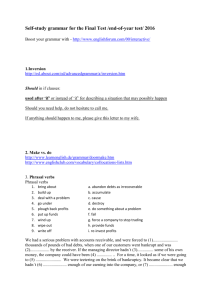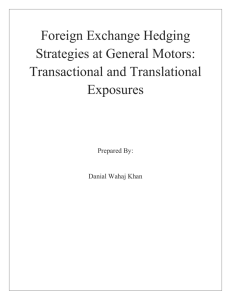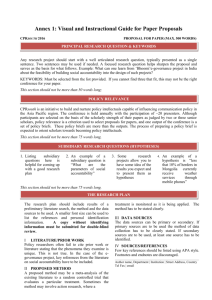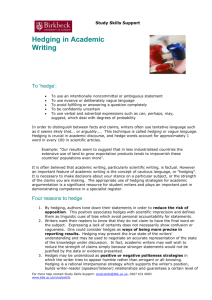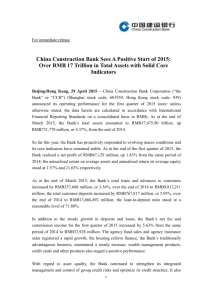37_4162_YukioHir...oMacroHedgingJFTC
advertisement
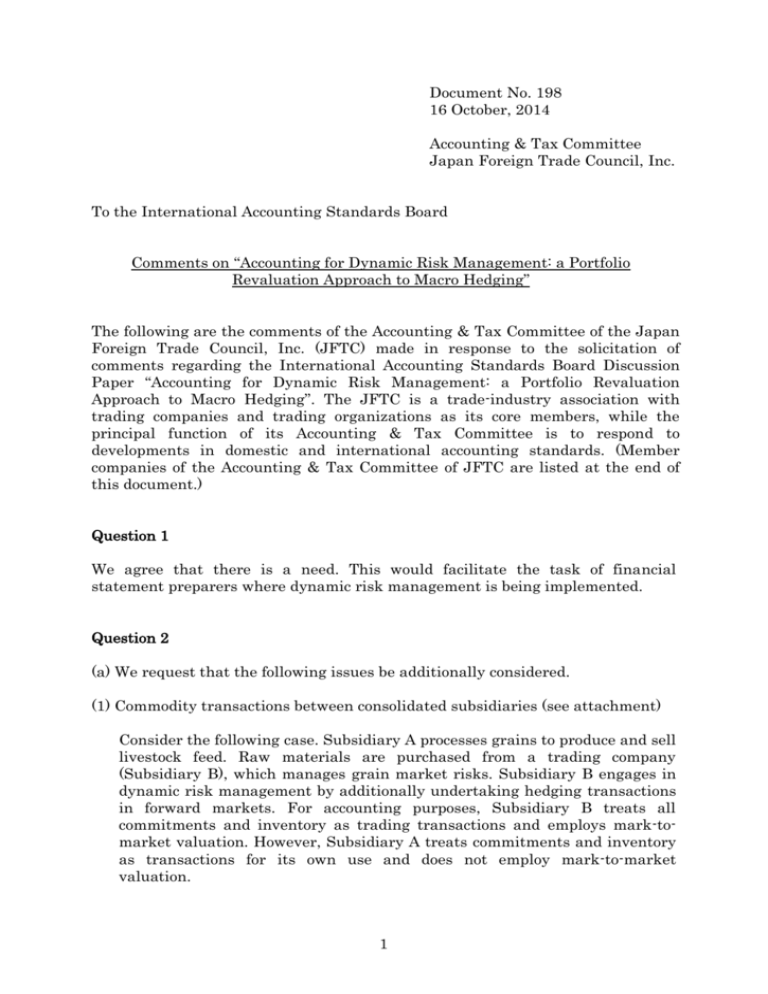
Document No. 198 16 October, 2014 Accounting & Tax Committee Japan Foreign Trade Council, Inc. To the International Accounting Standards Board Comments on “Accounting for Dynamic Risk Management: a Portfolio Revaluation Approach to Macro Hedging” The following are the comments of the Accounting & Tax Committee of the Japan Foreign Trade Council, Inc. (JFTC) made in response to the solicitation of comments regarding the International Accounting Standards Board Discussion Paper “Accounting for Dynamic Risk Management: a Portfolio Revaluation Approach to Macro Hedging”. The JFTC is a trade-industry association with trading companies and trading organizations as its core members, while the principal function of its Accounting & Tax Committee is to respond to developments in domestic and international accounting standards. (Member companies of the Accounting & Tax Committee of JFTC are listed at the end of this document.) Question 1 We agree that there is a need. This would facilitate the task of financial statement preparers where dynamic risk management is being implemented. Question 2 (a) We request that the following issues be additionally considered. (1) Commodity transactions between consolidated subsidiaries (see attachment) Consider the following case. Subsidiary A processes grains to produce and sell livestock feed. Raw materials are purchased from a trading company (Subsidiary B), which manages grain market risks. Subsidiary B engages in dynamic risk management by additionally undertaking hedging transactions in forward markets. For accounting purposes, Subsidiary B treats all commitments and inventory as trading transactions and employs mark-tomarket valuation. However, Subsidiary A treats commitments and inventory as transactions for its own use and does not employ mark-to-market valuation. 1 In this case, transactions between consolidated subsidiaries are eliminated. This results in an accounting mismatch equivalent to the mark-to-market value of profit/loss that accrues to Subsidiary B’s sales contract to Subsidiary A. It is theoretically possible to apply a fair value hedge to Subsidiary B’s external procurement transactions by making such transactions subject to hedging. However, it is practically very difficult for the trading company (Subsidiary B) to manage its transactions as linked transactions. To accurately reflect the substance of Subsidiary B’s transactions, we believe it is appropriate to incorporate Subsidiary B’s mark-to-market valuations of its commitments and inventory into the consolidated financial statements. Therefore, we request that consideration be given to deeming transactions undertaken with Subsidiary A to be external transactions and applying the PRA. (The DP accepts internal transactions as a proxy for external transactions.) Example1.pptx (2) Forward FX contracts related to outstanding balance of foreign currencydenominated commitments Consider a company that holds FX positions composed of a significant number of exposures. The position is centrally managed by the finance department, which in some cases uses forward FX contracts to hedge the net FX risk. In the accounting treatment of this case, items recognized as assets and liabilities are retranslated using the exchange rate of the balance sheet date. Because forward FX contracts are also subjected to mark-to-market valuation, profit or loss is automatically hedged. On the other hand, if hedge accounting is not applied to the FX risk on firm commitments, this will result in volatility in profit or loss. Regarding the application of hedge accounting to the net FX risk, hedging has now become possible with the adoption of IFRS 9. However, it remains necessary to identify specific hedged items and hedging instruments and link them via designation in individual hedging relationships. This represents a very difficult challenge in a management environment that is constantly changing. If items recognized as assets and liabilities as well as firm commitments unrecognized as assets and liabilities were to be included in the scope of a company’s dynamic risk management, the PRA would also be applied to firm commitments. This would resolve the above problem. Example2.pdf 2 (3) Credit default swaps covering claims on country with country risk Consider a case in which the need arises to use credit default swaps referencing sovereign risk to hedge a certain part of claims held against a country with country risk. As this would cover a considerable number of claims and liabilities with amounts fluctuating from day to day, it would be very difficult to link individual hedging relationships. Therefore, we request that consideration be given to applying dynamic hedging by treating the net position for the group of claims as an open portfolio. (4) Hedging of foreign net investments Regarding the hedging of foreign net investments, suppose the FX exposure of each subsidiary is hedged by its own business department. However, this does not necessarily mean that all positions are hedged. Moreover, positions are changing dynamically with changes in retained earnings, expected dividends, and other items. On the other hand, for example, suppose the need arises for the finance department to hedge a certain portion of the positions for the entire company. A general hedge cannot be used in this case because linking is difficult. Consequently, the company will have to use dynamic hedging. Because the DP does not touch on accounting treatment using OCI, we request that OCI treatment be considered with the above case in mind. Example3.pptx (5) Dynamic risk management of commodity price risk Suppose purchase and sales contracts for commodities and hedging transactions for these contracts are being treated as an open portfolio, which is then subjected to dynamic risk management. Suppose for accounting purposes, paragraph 5 of IAS 39 cannot be applied to these purchase and sales contacts for commodities (that is, the contracts are not treated as derivatives and lower-of-cost-or-market method is applied). In this case, if derivatives contain unrealized losses (to be recognized in profit or loss), then the unrealized profit contained in the purchase and sales contracts for commodities is not recognized in profit or loss, giving rise to an accounting mismatch. We request that consideration be given to application of the PRA. Example4.pptx 3 Question 4 Behavioralization basis should be restricted to cases with high probability. Moreover, we believe there is a need to define all the forecast transactions to be included in the PRA, such as pipeline transactions, prepayment, and core demand deposits. Furthermore, we request the application of these definitions to the dynamic management of commodity price risk, FX risk, and other noninterest rate risks. Japan Foreign Trade Council, Inc. World Trade Center Bldg. 6th Floor, 4-1, Hamamatsu-cho 2-chome, Minato-ku, Tokyo 105-6106, Japan URL. http://www.jftc.or.jp/ Members of the Accounting & Tax Committee of JFTC CBC Co., Ltd. Chori Co., Ltd. Hanwa Co., Ltd. Hitachi High-Technologies Corporation Inabata & Co., Ltd. ITOCHU Corporation Iwatani Corporation JFE Shoji Trade Corporation Kanematsu Corporation Kowa Company, Ltd. Marubeni Corporation Mitsubishi Corporation Mitsui & Co., Ltd. Nagase & Co., Ltd. Nippon Steel & Sumikin Bussan Corporation Nomura Trading Co., Ltd. Shinyei Kaisha Sojitz Corporation Sumitomo Corporation Toyota Tsusho Corporation Yuasa Trading Co., Ltd. 4



